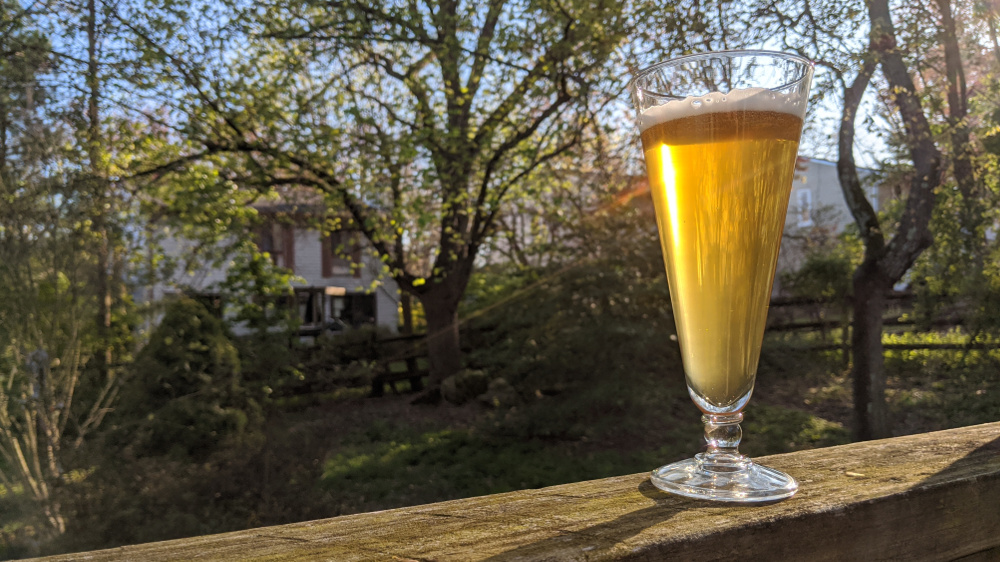
I’ve been homebrewing for nearly 10 years, but in that time I’ve only made one German beer, my recent Berliner Weisse. This neglect of the German styles needs to be rectified!
I love kolsch, and I’ve been happy to see it gaining a small but significant popularity in the US in the last decade. I think the only reason I haven’t made one is just that I’ve been distracted making lots of English bitters/milds and Belgain wits to satisfy my low bitterness session beer needs. The time for Kolsch has arrived.
When making a new style for the first time, I like to go with a trusted recipe. This beer is very close to The Mad Fermentationist’s Fall Kolsch. His example is on the bitter end for this style, but I think that will be to my liking.
Since it’s the end of March, not early September, I’ll call my version “Spring Kolsch”
Recipe
I used US 2-Row instead of pilsner malt just because we’re on coronavirus lock-down and it’s convenient to use what I have on hand.
On brew day I realized the original recipe was for 4.25 gallons where I was going to have 5.5 in the fermenter. I made some last minute modifications with what I already had in the freezer.
- Added some 60 minute Willamette to hit target IBU
- Also added 0.5oz of Hersbrucker at 5 minutes
Batch size: 5.5 gallons
Target OG: 1.047
Target FG: 1.010
Target ABV: 4.9%
Caluclated IBU: 33.1
Calculated SRM: 3.7
Grain bill:
8lb US 2-Row (80.8%)
0.75lb Vienna (7.6%)
0.75lb Wheat Malt (7.6%)
0.4lb Carahell Malt (4%)
Mash (Batch Sparge): 150 °F @ 1.5 qts/lb
Hops:
0.2 oz Wilamette @ 60 mintutes
2.0 oz Hallertau Mittelfrüh @ 60 minutes
1.0 oz Hallertau Mittelfrüh @ 5 minutes
0.5 oz Hallertau Hersbrucker @ 5 minutes
Yeast:
Decanted 1.5L starter (stir plate) of WLP029 Kolsch
Notes
2020-03-26 - Started the stater and put it in the fridge ~36 hrs later.
2020-03-29 - Uneventful brew day. Ended up mashing at 151 °F. Got ~5.75 gallons of 1.050 wort in the fermenter. I need to tweak my BeerSmith settings. Still getting used to the system. I’ve been generating more beer than I can actually keg with these settings.
Chilled to 68 °F, pitched yeast, and put in fermentation fridge set to 65 °F (temperature probe taped to outside of fermenter with some insulation)
2020-04-05 - Fermentation has been minimal the last few days. taking the beer out of the fridge to let it rest in the upper 60’s for a few days before kegging
2020-04-09 - Transferred into a purged keg. FG 1.011 (5.1% abv). The gravity sample is tasting nice already. Moderately bitter, light on hop aroma as it should be, but there’s a little bit in the background. Chilling and carbonating now.
Tomorrow I’ll add 1 tsp gelatin dissolved in 1/2 cup of 150 °F water and serve a couple days after that. (Not feeling patient enough for the traditional cold conditioning period. I’ll just see how it changes over time while I’m serving it)
2020-04-13 - This is already crystal clear and tasting great. Crisp, refreshing, enough bitterness that you wouldn’t confuse it with a macro lager. It’s spot on for what I was hoping to make. The perfect beer to enjoy after some spring yard work.
I’m curious to see if it changes noticeably while cold conditioning, but at this point wouldn’t hesitate to drink it this early again next time.

Changes for next time
- Would I bother with pilsner malt? Probably, just for the sake of experimentation.
- Fermentation was vigorous at 65 °F. I’d risk taking it a couple degrees lower next time.
- 100% Hallertauer Mittelfrüh
- Try going a little lighter on the alcohol. I’m curious how low I can take the abv without it tasting like a compromise. I bet this would still be good in the low 4%‘s abv.